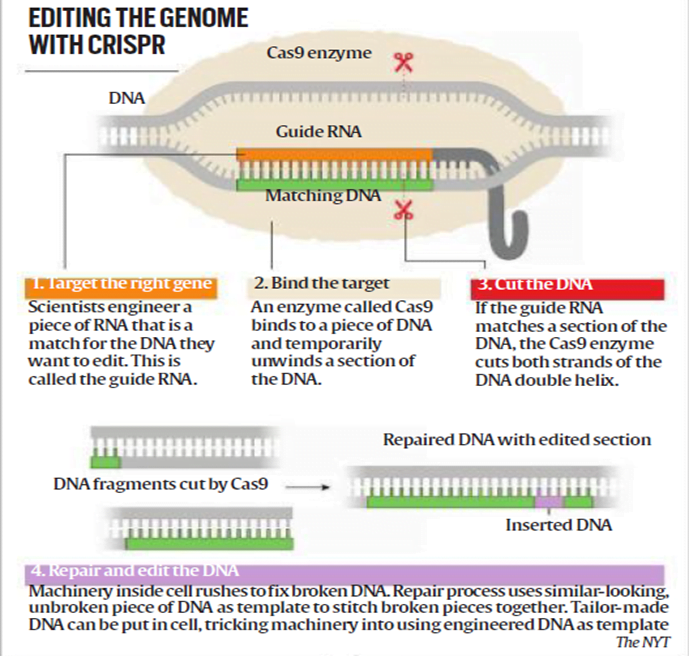Science and Technology
In News:
- India approved a 5-year project to develop CRISPR to cure sickle cell anaemia (it mainly affects tribal population) as this technology has produced flawless results in clinical trials.
Milestones of the technology:
- Debojyoti Chakraborty and Souvik Maiti at CSIR’s Institute of Genomics have indigenously developed CRISPR-based therapeutic solution to sickle cell anaemia
- Japan has approved cultivation of tomato variety improved using CRISPR-based intervention.
- Victoria Cray who was suffering from sickle cell anaemia has now been cured using CRISPR- based solutions.
About CRISPR:
- It is a gene-editing technology that ‘edits’ the genetic code of living organisms using biochemical tools like specific proteins and RNA molecules; by introduction of a new gene, or suppression of an existing gene, through a process described as genetic engineering.
- CRISPR is short for Clustered Regularly Interspaced Short Palindromic Repeats, which is a reference to the clustered and repetitive sequences of DNA found in bacteria, whose natural mechanism to fight some viral diseases is replicated in this gene-editing tool.
- It opens up the possibility of ‘correcting’ genetic information to cure diseases, prevent physical deformities or to even produce cosmetic enhancements.
- Jennifer Doudna and Emmanuelle Charpentier won the Nobel prize for chemistry in 2020 regarding CRISPR.

Steps:
- Identify troubled gene sequence
- An RNA molecule programmed to locate this sequence on the DNA strand (like ’find’ or ’search’ function).
- A special protein called Cas9 (also called ’genetic scissors’) breaks DNA strand at specific points to remove the bad sequence.
- Scientists intervene during the natural auto-repair process of the DNA strand by supplying the correct sequence of genetic codes, which attaches to the broken DNA strand. It is like cutting out the damaged part of a long zipper, and replacing it with a normally functioning part.
- It does not involve the introduction of any new gene from the outside.
- Its mechanism is often compared to the ’cut-copy-paste’, or ’find-replace’ functionalities in common computer programmes.
Applications:
It has near unlimited potential for permanent cures for some of the most intractable health disorders and improves the quality of human life with remarkable efficiency.
- Permanent cure to many diseases such as genetic diseases caused by unwanted changes or mutations in genes like sickle cell anaemia, eye diseases including colour blindness, several types of cancer, diabetes, HIV, and liver and heart diseases or hereditary
- Cure to deformities: arising out of abnormalities in gene sequences, like stunted or slow growth, speech disorders, or inability to stand or walk.
- Therapeutic solutions: Not in the form of a pill or drug. Instead, some cells of every patient are extracted, the genes are edited in the laboratory, and the corrected genes are then re-injected into the patient. The changes made are not passed on to the offspring
- Agriculture: to help develop genetically modified variants with specific desirable traits.
Way forward
The technology is not 100% precise and could induce few errors which may be passed to future generations.
A specific solution needs to be devised for every disease or disorder that is to be corrected.
Ethical dilemmas and potential for misuse of the technology must be considered around its development.
Source: Indian Express
Previous Year Questions
Q1. Consider the following pairs:
Terms seen in news Context/Topic
- Belle II experiment — Artificial Intelligence
- Blockchain technology — Digital/Cryptocurrency
- CRISPR – Cas9 — Particle Physics
Which of the pairs given above is/are correctly matched?
- 1 and 3 only
- 2 only
- 2 and 3 only
- 1, 2 and 3














